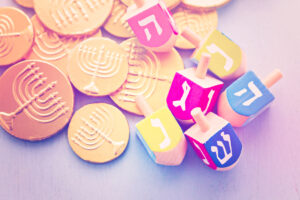- Jewish Holidays ⬦ Read ⬦ Uman
The Wondrous Craftsman – Amon Mufla (אמון מופלא)
The Wondrous Craftsman – Amon Mufla (אמון מופלא)
In the book of Proverbs, King Solomon speaks on behalf of the Torah, praising its greatness. The Torah itself claims to be the blueprint, the vessel through which Hashem created the world.
The verse reads (Proverbs, Chapter 8): “Va’eyeh etzlo amon – ואהיה אצלו אמון” which means, “I, the Torah, was with Hashem as His craftsman.”
The Midrash Rabbah (Bereishit 1:1) first offers four interpretations of the term “amon” used in this context:
- “Amon Pedagog,” akin to a newborn baby that needs constant care and attention. The Torah was under God’s nurturing guidance until it was ready to be revealed.
- “Amon Mechuseh,” meaning “covered up.” The Torah was there, but veiled, waiting to be uncovered when the time was right.
- “Amon Mutzna,” hidden. The Torah was not just covered but concealed, requiring effort to uncover its secrets.
- “Amon Rabbata,” big or precious. The Torah was something immense and significant for Hashem, awaiting the right moment to be unveiled.
However, the main interpretation is the fifth explanation – that the word “amon” means “uman – אומן,” a craftsman or an architect. The Torah describes itself as the vessel God used to plan and create the world, much like an architect’s blueprint for building a palace.
In worldly matters, even a king does not personally construct his palace. He hires an expert, an architect, who designs the palace’s layout on parchment and wax boards. Similarly, God consulted the Torah as His blueprint to craft and shape the universe.
In essence, the Torah was the master plan, the Divine blueprint from which Hashem fashioned the world. It’s a profound concept, emphasizing the Torah’s integral role in creation.
For those who embark on the Breslov journey, it’s important to understand that there will be ups and downs. This is the essence of Uman Rosh Hashanah!
The first four explanations revolve around how Hashem cared for the Torah, encapsulating the four levels of the Torah – Pshat, Remez, Drash, and Sod.
Let’s delve into the four levels:
- Pshat: This level demands substantial investment. To comprehend Pshat, one must dedicate time, intellectual rigor, and the capacity to follow the method of the Sages, which requires a sharpened intellect. This level embodies pedagogy, meaning it requires complete devotion. Thus being Amon – Pedagog.
- Remez: Remez introduces the notion of hints – uncovering hidden clues. Though it may seem somewhat concealed, these hints become evident through thoughtful connections and deeper consideration. Thus being Amon – Mechuseh.
- Drash: This level requires delving deep to unearth concealed insights. A Darshan aims to reveal something hidden, and is celebrated for his ability to bring out these exciting and innovative ideas. Thus being Amon – Mutzna.
- Sod: Sod ventures into the realms of Kabbalah, introducing profound concepts like Atzilut, Biriyah, Yetzirah, and Atzira etc.. It deals with esoteric, higher-level terms, offering a sense of awe akin to exploring the great vastness of outer space. Thus being Amon – Rabbata.
However, the Midrash’s fifth explanation corresponds to the level of the Infinite Light – the Or Ein Sof. This level transcends the previous four, considering them as mere prerequisites (which is why Hashem has to “pamper” them before they are revealed). The Or Ein Sof employs these 4 other levels of the Torah as vessels to bring about vast, infinite perspectives and perceptions, an experience called the Keter.
The Keter has a preliminary precaution from letting anyone access the Infinite Light. The Keter “bounces” a person backwards, away from his goal of advancing and perceiving the Infinite Light. This “bounce” allows for the formation of vessels that enable a person to perceive the Infinite Light in a passing and fleeting experience only.
The Tikkuney Zohar coins this sublime level of Godly perception as “Amon Mufla – אמון מופלא” – the Wondrous Handicraft, stating that it was the level of Keter – the Infinite Light which was the actual blueprint used by Hashem in the Creation.
Rebbe Nachman, in Likutey Moharan lesson 24, adds another dimension for the term Amon Mufla – Emunah (אמונה and אמון share the same root) in the Keter (כתר and פלא both connote that which is separated and beyond a person)!!!
Emunah in the level of Keter involves believing in a higher purpose when one experiences setbacks or challenges (the “bounces”), trusting that these difficulties serve to prepare the mind for greater revelations.
 Rebbe Nachman called himself a man of “Pele” (wonder).
Rebbe Nachman called himself a man of “Pele” (wonder).
He also chose the city of Uman as his resting place to work from there to rectify the entire world.
In this vein, “Amon Mufla” suggests a couple things:
- The Uman (Amon) of Rebbe Nachman (Mufla) – his resting place and the location of of his Rosh Hashanah gathering
- The Faith/Emunah needed in following Rebbe Nachman’s teachings, as he is a man of wonder – that he can help a person experience the Keter.
For those who embark on the Breslov journey, it’s important to understand that there will be ups and downs. The initial spiritual high may fade, but this process is integral to building vessels to receive the Infinite Light-Keter-Pele. Embracing and accepting the setbacks and difficulties is part of the preparation for receiving the Or Ein Sof. This is the essence of Uman Rosh Hashanah, where and when the Keter can be experienced.
In conclusion, Emunah is the key in navigating the Keter, and through it we can accept that the challenges and setbacks we face are part of the journey toward profound understanding and connection.
With blessings for a happy New Year, inscribed in the books of the True Tzaddikim for life, peace and happiness.
Uman, Uman Rosh Hashanah!!!
Meir Elkabas
- 0 comment






















